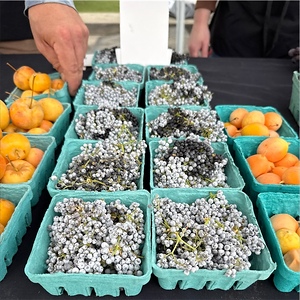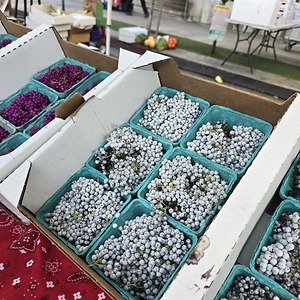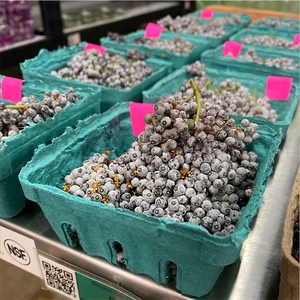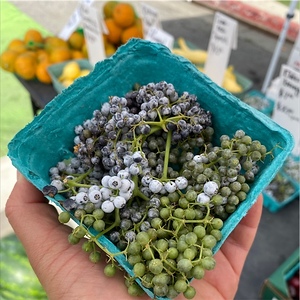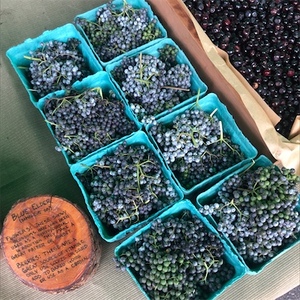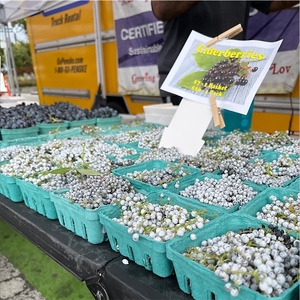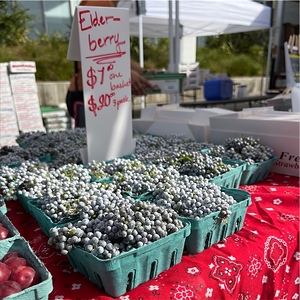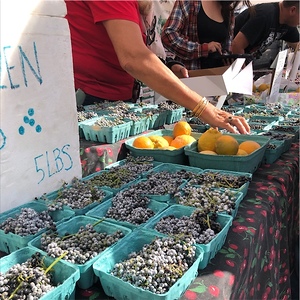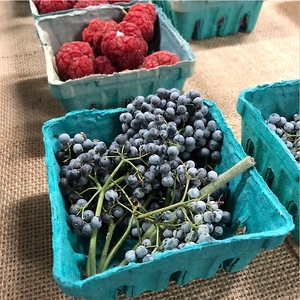

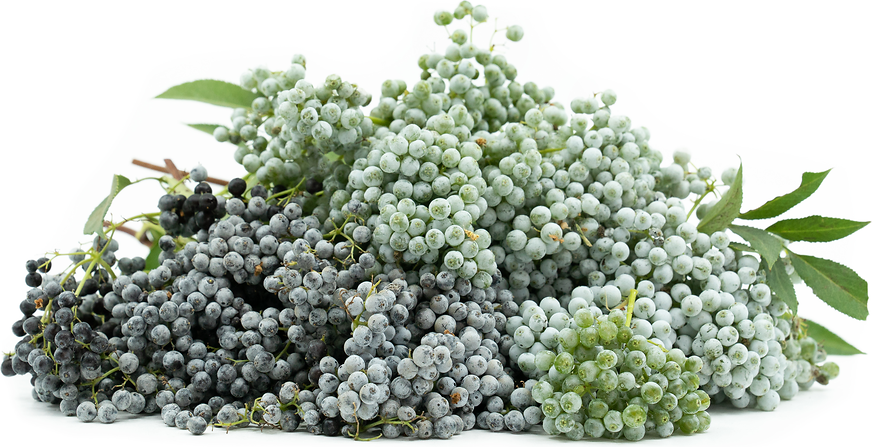
Elderberries Foraged
Estimated Inventory, lb : 0
Description/Taste
Elderberries are small in size, averaging less than one centimeter in diameter, and have a round, ovate, to oval appearance with somewhat uniform, curved edges. The berry's skin is smooth, taut, and delicate, showcasing purple-blue, blue, to dark purple, almost black hues. When the berries are unripe, they appear in shades of green and darken to purple-blue hues, often developing a powdery blue-grey bloom with maturity. Underneath the surface, the flesh is semi-firm, moderately juicy, and tender. Elderberries are toxic when unripe and mature berries should never be consumed unless cooked. The berries are also unpalatable in flavor when raw, having a tart, sour, and astringent taste. Once cooked, Elderberries will reduce in astringency but still retain a tart, tangy flavor. When mixed with sweeteners, they can also release subtly floral and fruity nuances, depending on the variety. In addition to the berries, the flowers are edible and are used as edible garnishes.
Seasons/Availability
Elderberries are available in the late summer through fall.
Current Facts
Elderberries, botanically a part of the Sambucus genus, is a general descriptor for several species of pigmented berries belonging to the Adoxaceae family. The tiny berries form in clusters on shrubs or small trees reaching 7 to 9 meters in height and are an ancient plant revered for its medicinal, culinary, and cosmetic uses. There are over 30 species of Elderberries worldwide, and the five main species include Sambucus nigra, or the European Elder, Sambucus canadensis, the American Elder, Sambucus ebulus, the European Dwarf Elder, Sambucus ceulea, the Blue Elder, and Sambucus racemosa, or the Red Elder. Red Elders are typically considered more ornamental for home gardens, and Elderberries, in general, are favored as a quick-growing plant in landscapes, often used as a hedge. Outside of home gardens, Elderberries are primarily foraged from wild plants and are commercially cultivated on a small scale for syrups, beverages, candies, sauces, and other cooked preparations. It is important to note that Elderberries are toxic when raw and must be cooked before consumption. Not all species of Elderberries are edible, so it is also worth mentioning that foraging for Elderberries should be done by a seasoned expert to ensure the species being collected is non-poisonous.
Nutritional Value
Elderberries have been used for thousands of years in folk medicines throughout the Northern Hemisphere. The berries are traditionally cooked and added to tea, syrups, and lozenges and are thought to strengthen the immune system against colds and flu. The berries were also incorporated into infusions to topically soothe skin irritations or reduce fevers. Morning dew from the plants was collected and used to wash the face, believing it would bring rejuvenation and repair. While there has not been enough research and studies to prove these claims, Elderberries are touted as a source of vitamin C to strengthen the immune system, fiber to regulate the digestive tract, iron to develop the protein hemoglobin for oxygen transport through the bloodstream, and potassium to balance fluid levels throughout the body. The berries also provide vitamin A to maintain healthy organ functioning and anthocyanins, plant pigments that give the berries their dark purple-blue, almost black hue. When diluted with water, the pigments will create a red-purple liquid, used as a natural food dye. Uncooked berries contain cyanogenic glycosides, which are considered toxic and may induce diarrhea, nausea, and other harmful side effects.
Applications
Elderberries must be cooked before consumption and are considered toxic when raw. Cooking Elderberries with sweetener also reduces the berry's astringent, tart taste and creates a subtle floral and fruity flavor. The berries are popularly used to make jams and jellies and are simmered into syrups for desserts, beverages, and medicinal uses. Elderberry syrups are also drizzled over ice cream, mixed into yogurt, or blended into smoothies. In addition to syrups, Elderberries are cooked into sauces for roasted meats, simmered into fillings for pies, infused into chutney, or made into hard candies. The berries are also cooked and added to teas, mixed into cocktails, and used in wine, cordials, and infused liqueurs. One of the most well-known Elderberry-infused liqueurs is the French brand St. Germain. Elderberries pair well with other ingredients such as berries, stone fruits, apples, dried figs, roasted nuts, vanilla, coffee, chocolate, and spices, including nutmeg, ginger, allspice, and cloves. Whole, unwashed Elderberries will keep for a few days when stored in the refrigerator.
Ethnic/Cultural Info
Elderberries have been intertwined for centuries in regional folklore and mysticism. One of the early legends involving Elderberries was based in Europe and spoke of the spirit of the Elder Mother residing in the plant. The Elder Mother appears in English, Scandinavian, and Dutch stories under several names, including Hyldemoer, and is the nymph or goddess of creation, life, and death. Since the Elder Mother resided in Elderberries, many feared the plant and thought that if it were to be cut down or damaged, the Elder Mother would release horrible curses. It was also believed that the Elderberry plant was not commonly struck by lightning because of the spirit's presence, making it a popular plant to place besides buildings and villages. If one had to remove a portion of the tree, it was customary for them to kneel and recite a chant out loud three times in a row to prevent any curses from being placed, saying, "Lady Elder, give me some of thy wood, then I will give thee some of mine when I become a tree." Throughout history, Elderberry plants were also used to repel evil spirits and witches, distract vampires from entering windows, and provide wood for musical flutes for fairies. Some European communities even believed that if they sat under an Elderberry tree at midnight on midsummer's day, they would catch a glimpse of the king of fairies passing by with his noble court. The most recent reference to Elderberry plants was in the Harry Potter series, where wood from the plant was used in the infamous Elder Wand.
Geography/History
Elderberries are an ancient plant native to several regions worldwide. Most of the species are found in the Northern Hemisphere, with a few species present in South America and Australasia. Experts hypothesize that the plants were spread around the world during the Ice Age from 12,000 to 9,000 BCE and became established in temperate to subtropical regions, especially in canyons, forests, along river and stream banks, and on sloping, fertile landscapes. One of the oldest records of Elderberries in cultivation was a collection of seeds that date back to the Neolithic pole-dwelling civilization in Switzerland, believed to have existed around 2000 BCE. Since the beginning of time, Elderberries have been revered and feared for their mystic reputation, and the berries were mentioned in the medicinal writings of Hippocrates and Pliny the Elder. They were also used in folk remedies of Ancient Egypt, and in North America, the Native Americans used the entire plant for medicinal, culinary, and cultural practices. Today Elderberries have retained their magical reputation and have been the subject of many health debates regarding their efficacy as a superfood. The berries are still used in natural home remedies worldwide and are cultivated on a small scale for culinary, medicinal, and cosmetic use. When in season, fresh Elderberries are found through specialty grocers, distributors, and farmers markets.
Recipe Ideas
Recipes that include Elderberries Foraged. One
| Simply Recipes |
|
Elderberry Jelly |
| Almond Corner |
|
Elderberry Tartelettes |
| Namely Marley |
|
Elderberry Pie |
| David Lebovitz |
|
Elderberry Syrup |
Podcasts



